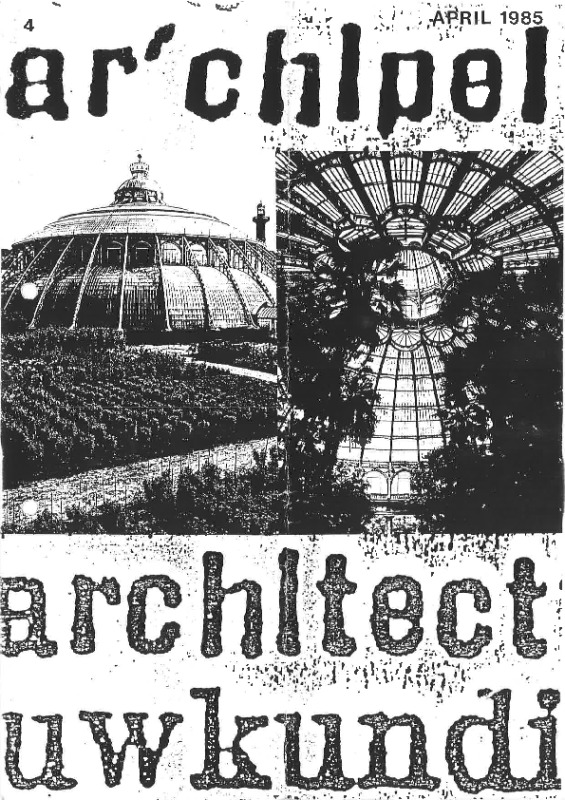Brussels: Royal Greenhouses + Botanique
(Autotranslation)
- Visit in Brussels Royal Greenhouses in Laeken architect Alphonse Balat 1886-1892; (The building is just a few days open to the public).
- Visit exhibition Belgian Reconstruction 1914 “Resurgam”.
- Visit the Botanical Gardens Complex ‘Botanique’, the recently restored kutureel center for the French community; currently running an exhibition ies Felicien Rops.
Royal Greenhouses in Laeken: Alphonse Balat (1886-1892)
Leopold II Balat in 1860 officially to his architect and titre (personal architect) nominee, gave him the mid 70’s command to build the Royal Greenhouses at the Palace of Laeken. Officially it is called Leopold had built the greenhouses because “his passion for flowers and plants, but it’s clear that he mainly referred to as a sign of its colonial power in Congo.
That was also the case for the greenhouses that the English crown had already established in the first half of the nineteenth century, whose famous Palm Stove from 1845-48 at Kew Gardens (south of London) Leopold probably inspired. Meaningful for the confidence with which Leopold’s colonial future looked forward to was the fact that he was the first conservatory, the winter, already did perform in 1874-76, so when Stanley’s expedition along the Congo River had not yet ended.
The need to work with iron and glass led Balat for a single time in his career on the classical idiom and brought him to the development of original construction and space structures. He built the winter garden at a number of concentric suitable cast iron trusses that supported extra half their span by a circular Doric colonnade. The frames also reach across this gallery go to also rest on the ground so that the greenhouse image offers a glass dome which is braced by Gothic flying buttresses, a construction or in the flavor would have fallen by Viollet-le-Duc1, that just felt that the new architecture would arise from the application and development of the Gothic principles contemporary materials and techniques.
Later, after Congo in 1885 to Leopold’s personal colony had become Balat was commissioned to build more greenhouse pavilions: in 1886 the Congo Conservatory, evolving from a square floor plan via some geometrical artifice into a dome; connected to it the more classic Diana Conservatory that overlooks the park; finally in 1892-93 the iron church, a kind Bysantin volume surrounded by radiating chapels, which housed the royal chapel.
What Balats greenhouses particularly original and is fascinating is not just the fact that they already form the language of Art Nouveau announce but also let him through glazed galleries to a complex system with another covenant. The greenhouses were not isolated objects, but they are part of a kind of glass city in which the game of perspective and reflections along with the exotic vegetation creates intriguing spatial relations, already referring to the Art Nouveau area of Horta.
from the book:
- The Royal Greenhouses *
Edgard Goedleven
The Royal Greenhouses are part of the Royal Estate, the residence of the Belgian royal family, since Belgian independence.
The Royal Domain, however, is older than 1830. In 1781 bought the Austrian Governors-General Maria Christina and Albert of Saxony Teschen who ruled the country on behalf of the Austrian Emperor Joseph II, the Schoonenberg Laeken and built a magnificent castle already completed in 1784 was. However, the Austrians would not enjoy their property in Interlaken because Belgium was annexed by France in 1794 and left the Austrians our country. The property was purchased in 1804 by Napoleon left organizing it as his residence in our regions. After the defeat of Napoleon at Waterloo in 1815 led to the acquisition of King William of the Netherlands.
Since the Belgian revolution in 1830, the residence of the Belgian royal family. The second Belgian King Leopold II would enhance the beauty and value of the estate still vulnerable due to the construction of the Chinese Pavilion and the Japanese Tower.
The Royal Greenhouses, a true glass city were also built by Leopold II. He suggested this to the architect Balat, one of the most important Belgian architects of the nineteenth century, which brought about an architectural masterpiece with the glass city.
The greenhouses consist of two parts, the palm plateau and winter garden complex; both are connected to a large glass gallery; they form a contiguous and covered entirely with a length of one kilometer. The planting of the greenhouses harmony with the architecture. Many plants have a historical value.
Leopold II in Belgian history, best known as the founder of the Congo, Zaire today. However, he was also a great builder. It was his intention to small Belgium by spectacular and display works of genius prestige in Europe.
He made the Ostend Queen of Seaside Resorts and also explained the beautiful park of Tervuren with the museum ear Central Africa. His main achievement, however, was the domain of Laeken, he wanted to build a Palace of the Nation for international conferences and receptions.
Though his death in 1909 and shortly after World War broke out in 1914 prevented his plans were fully implemented, would remain the royal greenhouses, now almost fully restored, a testimony to the efforts of Leopold II with his works proved how a small country However, it can be large.
